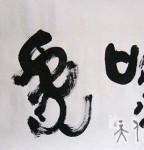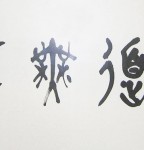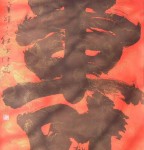Chinese calligraphy is a unique gem of Oriental culture. Graphically, it is comparable to painting in its ability to express emotion through a rich variety of form and design. As abstract art, it displays the rhythmic and harmonious flow of music. And from a practical point of view, it is written language.
Tradition
Writing is a tangible representation of spoken language. The composition of Chinese characters is divided into six basic categories:(1)hsiang hsing, direct pictorial representation; (2)chih shih, symbolic renderings of abstract ideas; (3)hui yi, a combination of pictorial elements with symbolic renderings of abstract ideas; (4)hsing sheng, a combination of phonetic and pictorial elements; (5)chia chieh, a character used only for its phonetic value to represent an unrelated homophone or near-homophone; and (6)chuan chu, a character which has taken on a new meaning, and an alternate or modified written form has been assigned to the original meaning. These methods of composing Chinese characters are referred to as the Liu Shu, or "Six Writing Methods".
With the "four treasures of the study" as tools, and through the medium of lines, China's calligraphers have developed uncounted different calligraphic styles over the centuries. However, this plethora of diverse styles can be grouped into five basic categories: Chuan Shu, Seal Script; Li Shu, Official Script; K'ai Shu, Regular Script; Hsing Shu, Running Script; and Ts'ao Shu, which literally means "Grass" Script, but is usually referred to as Cursive Script.
Each style is unique yet similar to every other style. In the Seal Script style, vertical and horizontal lines are fine, uniform, forceful, and tend to be slightly pointed on the ends. The Official Script style emerged to deal with the growing number of official written documents. The style could be executed quickly because it consisted of extremely straight vertical and horizontal lines and a tight structure. And even though it was designed by modifying the Seal style, it was considerably faster to right. The Regular Script was developed during the Han dynasty (206 B.C.-220 A.D.) based on the Official Script. Because it was even more convenient than the Official Script style, the Regular Script style was used for everyday purposes in the Han Dynasty. The Running Script is a cross between the Regular Script and Cursive Script, and its name come from the "running" manner in which it is executed. The "Grass" or Cursive Script features a simplified structure, the running together of strokes, rapidly written and flowing lines, and a low level of legibility. A Chinese Saying expresses the beauty of the Cursive Script: "The writing stops but the meaning goes on; the brush has been put down but the power is unending".
Chinese calligraphy is not only a practical tool of everyday living but also along with traditional Chinese painting compromises the mainstream of China's art history. All kinds of people have avidly collected works of fine calligraphy. And works of calligraphy are to be found everywhere you look: on shop and government office building signs, on monuments, and in stone inscriptions. All of these examples of Chinese calligraphy have supreme artistic value.
The Present
Today, as in the past, calligraphers are often literati as well as artists. Their calligraphic works may include renderings of their own poems, lyrics, couplets, or letters; or those of famous masters. It is obvious Chinese scholars still place great importance on calligraphy. In China, calligraphy is a major subject from elementary to high school and even in post secondary schools. Calligraphy clubs and associations are popular in all regions, and calligraphy receives strong support from various foundations. In this technological information age, it is encouraging and satisfying to note the enthusiastic public interest that Chinese calligraphy continues to generate.
| < Prev | Next > |
|---|
- 2013-12-29 - 巨人毛泽东百二十诞辰: 丁仕美草书“毛诗词”网上大展之前言
- 2013-06-24 - 字为心画:气韵藏于笔墨
- 2011-03-29 - 《法书要录》十卷, 唐 张彦远 撰《卷一》
- 2011-03-15 - Basics Knowledge of Chinese Characters & Symbols
- 2011-01-09 - 从史籍无闻到“天下第一行书”——浅析唐太宗对《兰亭序》的“接受过程”
- 2010-12-30 - History of Chinese calligraphy : South North and Sui dynasty
- 2010-12-24 - Oracle Bones of Ancient ChinaOracle Bone Script
- 2010-12-23 - 论用笔与结字:书法艺术成熟的三大历史阶段












